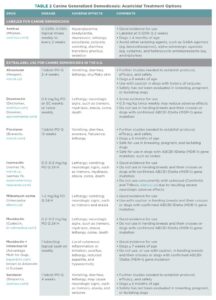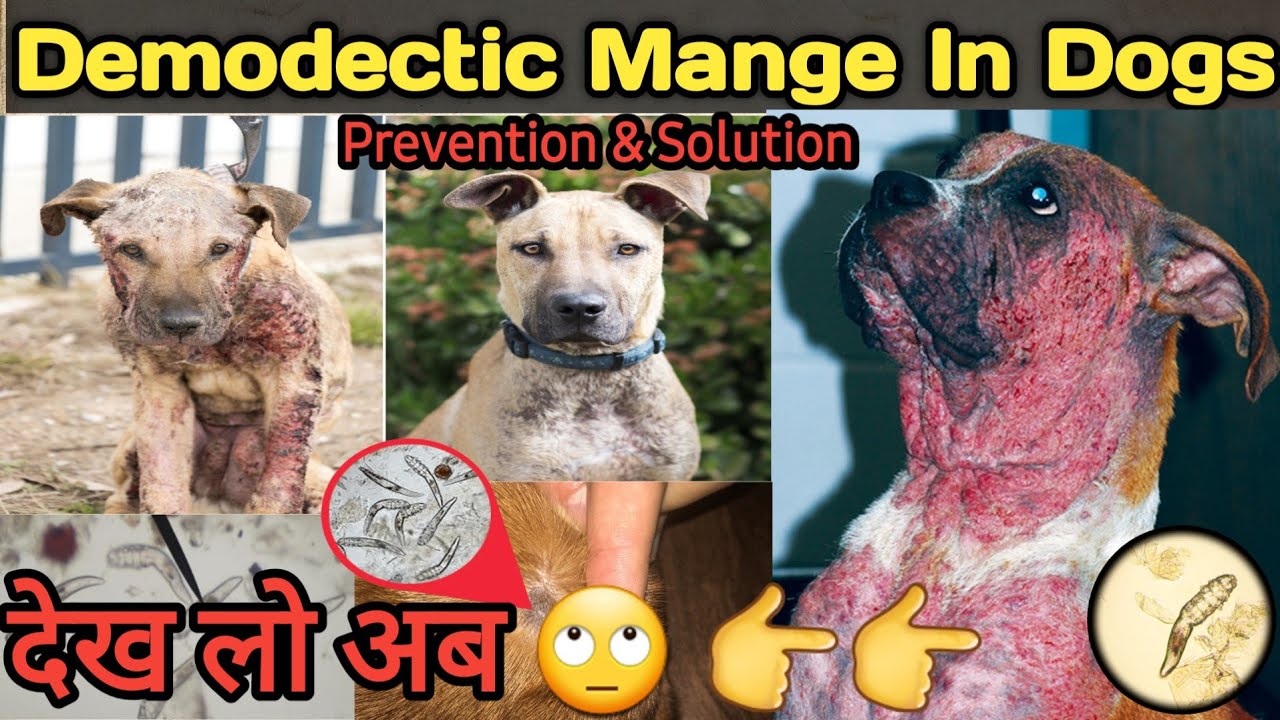Demodectic Mange in Dogs
Canine demodicosis is one of the most common cutaneous infections encountered in canine practice. The disease is defined as an inflammatory skin infection of parasitological origin. Canine demodicosis is a common inflammatory parasitic skin disease believed to be associated with a genetic or immunologic disorder. This disease allows mites from the normal cutaneous biota to proliferate in the hair follicles and sebaceous glands, leading to alopecia, erythema, scaling, hair casting, pustules, furunculosis, and secondary infections. The face and forelegs to the entire body surface of the dog may be affected.
Three morphologically different types of Demodex mites exist in dogs:
- Demodex canis: The most common form of Demodex
- D cornei: A short-body form, likely a morphological variant of D canis
- D injai: A long-body form
Demodicosis may be localised, generalised (juvenile onset or adult onset) or demodectic pododermatitis. Some cases of pododermatitis may have originated as generalised cases but not resolved, while others present just with pododermatisis but are still considered under the generalised heading.
Generalised demodicosis due to D. canis is one of the oldest dermatoses to be described in veterinary literature. In the Middle Ages, it was known as “redde mange” due to the erythematous lesions of some cases . Juvenile onset demodicosis is the most common type of generalised case and is described here.
Until recently, juvenile onset demodicosis was considered a difficult condition to cure and earlier texts warned that euthanasia needed consideration in the most advanced cases. Recent advances in treatment have altered this guarded prognosis into a favourable outcome for the majority of affected dogs.
It is known that a genetic predisposition to develop generalised juvenile demodicosis exists. The primary defect leading to the disease is unknown, however. With advanced mite proliferation, dogs develop T-cell exhaustion favouring increasing mite proliferation and secondary pyoderma. Treatment with effective acaricidal products reverses T-cell exhaustion and leads to a clinical cure. It is unclear why some dogs develop generalised demodicosis at a young age and why these dogs after treatment usually remain cured. If there were an underlying primary genetic cause, it would be logical to expect relapse to be common, but that is not the case. It has been suggested that dogs with demodicosis have an inherited Demodex specific T-cell deficit of varying severity (Miller et al., 2013).
There are four stages to the life cycle: eggs (lemon pip shaped), six-legged larvae, eight-legged nymphs and eight-legged adults. The mites are transferred from the mother to the pups in the first two to three days of life, which explains why lesions tend initially to involve facial and pedal regions. After initial transfer of mites has occurred, the disease is non-contagious.
Treatment of canine demodicosis
Treatment of canine demodicosis is designed to resolve inflammation and thereby reduce any secondary skin infections and/or fur loss and ideally to remove the mites from the skin. The majority of localized cases will spontaneously resolve with no antiparasitic treatments needed. Generalized demodicosis is not necessarily a marker of general immunosuppression (Cushing’s syndrome, hypo-thyrodism, neoplastic malignancy or immune suppressive treatments). In patients with demodicosis and a comorbidity of immune altering conditions the resolution of the parasites will often be faster with fewer setbacks if the immune altering condition can be controlled. The gold standard of treatment is to reach two negative skin scrapings from previously affected sites within a 30 day interval. Treatments should be tailored to fit the patient’s signalment and to avoid using protocols interfering with medications needed for any concurrent health issues (seizures, MDR-1 defect, or food adverse reaction). Many commonly used demodex treatments are not registered specifically for canine demodicosis by the FDA or the EPA (e.g. Ivomec, Milbemycin).
Amitraz (Mitaban®) dip: Mitaban dip immersion bath is a FDA approved drug for this disease, but toy and tea cup breeds should not receive full treatment concentration. Dips are usually applied either weekly or every two weeks. Whole body clipping is often required for long-haired dogs throughout treatment so that the dip solution can reach the mites down in the hair follicle. Side effects of Mitaban include sedation, decreased body temperature, loss of appetite, vomiting, diarrhea and the odor of the dips is not pleasant. Treatment with an antidote, Yohimbine, can be used to decrease the severity of some Mitaban dip side effects. Eye lubrication may be needed if significant conjunctivitis is a problem of treatment. Spot-on Amitraz products (e.g., Certifect®) used primarily for flea and tick prevention also have some reported effect on demodicosis, and an earlier similar product (Promeris) was discontinued after an association with outbreaks of pemphigus was shown to occur in a small number of patients treated.
Lyme Sulfur dips can be used for demodicosis and are particularly effective in the earlier phases of treatment of very severe cases of generalized demodicosis with severe furuncolosis forming deep pyoderma. Its low cost and minimal toxicity makes it a safe but foul-smelling option in very young animals and animals at risk for toxicity or side effects as well as in cases with multi ectoparasitic disease.
Ivermectin (Ivomec®, Eqvalan®) is available as an injectable liquid or oral paste as a deworming agent for production animals. It can be given orally daily as a liquid to dogs to treat demodicosis. Subcutaneous injections will often cause injection site discomfort and can result in sterile abscess formation after long term use. Some dogs, especially herding breed dogs and animals with drugs affecting the blood brain barrier p-glycoprotein function, can have central nervous system sensitivity to the higher doses of ivermectin (MDR-1 or ABCB-1 gene defect) needed for demodex treatments. Signs of ivermectin sensitivity include sedation, drooling, loss of balance, vomiting, seizures, and, rarely, blindness. A genetic test is available to help determine if an individual dog may be sensitive to ivermectin. Dogs are first started on a low dose of ivermectin and then gradually given a higher dose while monitoring for side effects. Antifungal azoles such as fluconazole, itraconazole, and ketoconazole can affect the absorption, clearance and metabolism of ivomec.
Doramectin® and Moxidectin (Cydectin®, Advantage Multi®) is available as a liquid deworming (pour-on and injectable) agent for sheep and cows and as part of canine flea and heartworm preventive spot-on products. It can be given daily as an oral liquid to dogs to treat demodicosis and is also available as part of a spot-on product (Advantage Multi®) for weekly application, but is only registered for demodicosis outside the US. This product can be used in ivomec sensitive breeds as it is not a p-glycoprotein substrate, but other forms of neurotoxic like side effects have anecdotally been reported with the use of the injectable form.
Selamectin (Revolution®) topically is less effective although a few studies looking at oral use (evaporated on bread to avoid carrier vehicles) have shown some efficacy, but it is likely not the most practical option in clinical settings.
Milbemycin oxime (Trifexis®, Sentinel®, and Interceptor®) is available as a heartworm preventive pill for dogs. It can be given daily to dogs to treat demodicosis. Some breeds can have central nervous system sensitivity to high doses of milbemycin, but this is less common than a sensitivity to ivermectin. Signs of milbemycin sensitivity include sedation, drooling, loss of balance, vomiting, seizures, and rarely blindness. Cost will often become an issue.
Fluralaner; (Bravecto™, Nexgard®, and Simpirica®) is a new class of antiparasitic drugs targeting fleas and ticks, but lately has been shown to have a promising effect on some forms of sarcoptic and demodectic mange in dogs. Depending on the product, the treatment will have to be repeated monthly or every 90 days until the two negative skin scrapings have been accomplished.
With more findings in PCR and DNA sequencing of mites as well new treatments for canine demodicosis the possibilities are promising from the perspective of clinicians. With more options of treatments, it will likely allow us to tailor the demodicosis treatments to high risk patients, for example with known adverse reactions to antiparasitic classes of drugs or with complex health issues (seizure disorders, liver disease, etc.) We see this as a good opportunity to work with clients and hopefully also breeders so we can find ways to reduce the overall incidence of this disease in our pets.

Control and prevention
To prevent your dog from getting demodicosis, it is important to note the following points: i) control mite should be made by frequently clean the dog’s place (2 times a week or more) and particular attention should be given to places where the animals sleep; ii) disinfect dog toys to avoid carrying pathogens; iii) deworming and treat ticks periodically. Use of isoxazolines may offer advantage of parasite control for Demodex along with prevention of other parasitic diseases including fleas, ticks, ear mites, etc; iv) a reasonable dog diet, vitamin supplements, adequate nutrition for dogs. Some studies have shown that a weak immune system is a favorable condition for demodicosis infection.
HIGHLY RECOMMEND PREVENTION PRODCUTS FROM CANINE DEMODICOSIS IN PETS
| Name of Product | Benefits | Ingredients | |
| Skin care | Medicated shampoo with chlorhexidine digluconate. Anti itching and deodorizing. Treatment of dermatitis. | Chlorhexidine digluconate 31.2 mg
Exp.qs 1 ml
|
|
| Micona Shampoo | Antifungal and antibacterial shampoo for dogs | Chlorhexidine digluconate 20 mg
Miconazole nitrate 20 mg
|
|
| Micona Spray | Treatment for Folliculitis, Dermatitis and Fungal infection on skin | Miconazole nitrate 20 mg
Excipients 1ml
|
DR UDAY KUMAR,CANINE SPECIALIST,PATNA
REFERENCE-ON REQUEST
IMAGE-CREDIT-GOOGLE


